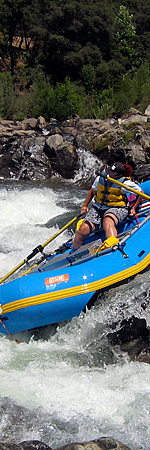Running on Snowmelt
If you're a river guide living in California, when the weather warms up your thoughts inevitably turn to snowmelt. The massive Sierra Nevada snowpack that is melting into the rivers spilling out of the highest mountain range in the continental U.S.
You watch the flow like surfers watch the surf. And if you're blessed, or cursed, one day you may even see a flood. That happened to me once.
In the winter of 1983, it was a classic case of rain on top of snow, which led to a kind of super-melt that spun the Stanislaus River (now usually under the god-forsaken waters of the New Melones Reservoir) up to 25,000 cubic feet per second and rising. It was like running the Colorado River through the Grand Canyon, but in a small water river bed. It was, in other words, a completely different river than anyone had ever seen before.
And coming from everywhere were two dozen river guides who simply had to experience it. I can remember bouncing around in the eddy before shoving off, wondering if it was too late to pull out. I could sense that it was ridiculous to be trying this, almost insane. I think having so many experienced people around me helped, but I was stupid. In the end, when the river took you down, you were alone.
No one knew that better than the couple who were the first to flip — in a rapid just downstream from put-in. One of them caught a tree on the bank but the other swam for three miles before anyone could get close enough to pull her out. She was so hypothermic she couldn't move.
I rowed my boat for the first three miles, until I couldn't row anymore. It was like one continous rapid that you had never seen before. Rocks that you would have to maneuver around in "high" water were now completely covered, making huge holes that those who entered would not exit upright. The rain was pouring down, making it difficult or impossible for me to see through the rain on my glasses. Luckily, I happened to have a good friend and Grand Canyon Dory boatman in my boat. I asked him to help me spot the holes and rocks I had to miss. At the end of the three miles I was winded — without a breath to spare. He jumped to the oars and gave me a break.
I didn't realize it at the time, but dories handle very differently from the raft that we had that day. Downstream we saw a "V" wave that rivaled those of the Grand Canyon. The Grand Canyon dory boatman at the oars rowed it like he was used to — like a dory. The problem is that rather than punching through the wave like a dory would (with a sharp prow), the rounded snout of the rubber raft surfed along the wave and made the boat do a "tube stand" along the V-wave. A tube stand is where the boat is lifted perpendicular on the side tube. Everyone except me fell out of the boat. I only remained because I stood up on the side tube. When the boat fell down upright, I jumped back to the oars and picked up one of the two people in the water. The other was picked up by another boat.
In the end, none of us ever forgot that trip. Some of the most experienced Stanislaus River guides were on the river that day, including Mark Dubois, who rafted the flooding Stanislaus on that cold, rainy day barefoot and in shorts.
I'm telling you, anyone who is a river guide in California in the Spring is thinking about the snowmelt, and for some very, very good reasons.

